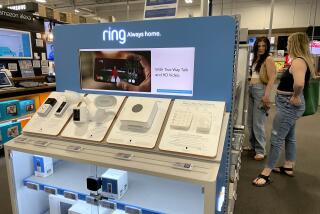A Small Wish for Big Changes in Electronics
- Share via
Give me a remote control that could change anything in the world (as long as it plugs into a wall or runs on batteries), and here’s where I would start . . .
Make it simple. The nation that admitted, in a moment of self-flagellation, that it could not set a VCR’s clock now has 20 million households with a home theater, according to the Consumer Electronics Assn.’s latest count. It’s a remarkable statistic, given the relatively new phenomenon of home theater and its most integral component, the DVD player.
But that leaves 80 million households without a home theater. We’ve all heard the reasons. It costs more. It takes up too much room. It’s too loud.
Or maybe it’s just too hard. Seen an audio-video receiver lately? It makes a VCR look like the latest Fisher-Price toy for 2-year-olds. If programming a VCR blows a fuse in your brain circuitry, then you’re risking spontaneous human combustion with an audio-video receiver.
One receiver I tested recently arrived with a 70-page manual in a loose-leaf binder. Seventy pages. It took me less time to get through “Tuesdays With Morrie.” This is too much for average consumers. It’s an audio-video receiver, not the space shuttle. Keep it short; keep it simple. Make it comprehensible.
*
Better yet, make it . . .
Plug-and-play. Someday soon, maybe you politely can tell the writers of those 70-page manuals to shut their techie mouths. You won’t be needing those mega-manuals once home-theater equipment starts taking a page out of the PC book by using the FireWire interface. It’s already happening. Several manufacturers, including Harmon Kardon, JBL, Denon and Onkyo, are promising products powered by FireWire technology licensed from Digital Harmony Technologies.
With Digital Harmony, all you’ll do is plug in a component, and it will be recognized automatically by all the other equipment in your home theater also outfitted with Digital Harmony. All digital audio, video and control signals are sent through the FireWire interface.
The age of the simple setup approaches.
Have a plan. Nothing comes easy with electronics. DVD is only now taking off after agonizing delays over copyright issues and a needless showdown with the stillborn DIVX. DVD-Audio has been delayed until at least mid-2000, again because of copyright issues, giving the competition--the Sony/Philips Super Audio CD--a head start.
Consumers too often are asked to choose between two versions of the same technology. Beta or VHS? Digital audio tape, Digital Compact Cassette or MiniDisc? When the nation shifts from AM-FM radio to DAB, or Digital Audio Broadcasting, consumers might have to choose from two standards--USA Digital Radio and Lucent Digital Radio--or the Federal Communications Commission might require all digital radios be compatible with both standards.
Forget about the black box. Who wants to be the Apple of the electronics industry? It’s time for a product, like the iMac, to change electronics design. There’s a place in music, and movies, for beauty. Let there be more designs like the gorgeous Marantz MR2020 Tabletop Music System and the growing number of “lifestyle” and “executive desktop” systems. Try some rounded edges, some unusual shapes, some different colors. Do something. What is this, the 1900s?
Fair competition. Break the monopoly of local cable companies. The Satellite Television Home Viewers Act signed Nov. 29 by President Clinton gives satellite companies freedom to carry local channels and, with it, a better chance to compete against cable companies. But if the FCC enforces the “must carry” regulations that would require the satellite companies, like the cable companies, to carry every local channel--not just the major-network affiliates, it could doom any possibility of real competition. Lack of transmitter space and cost could limit the satellite companies to carrying local channels only in the biggest, most lucrative markets.





